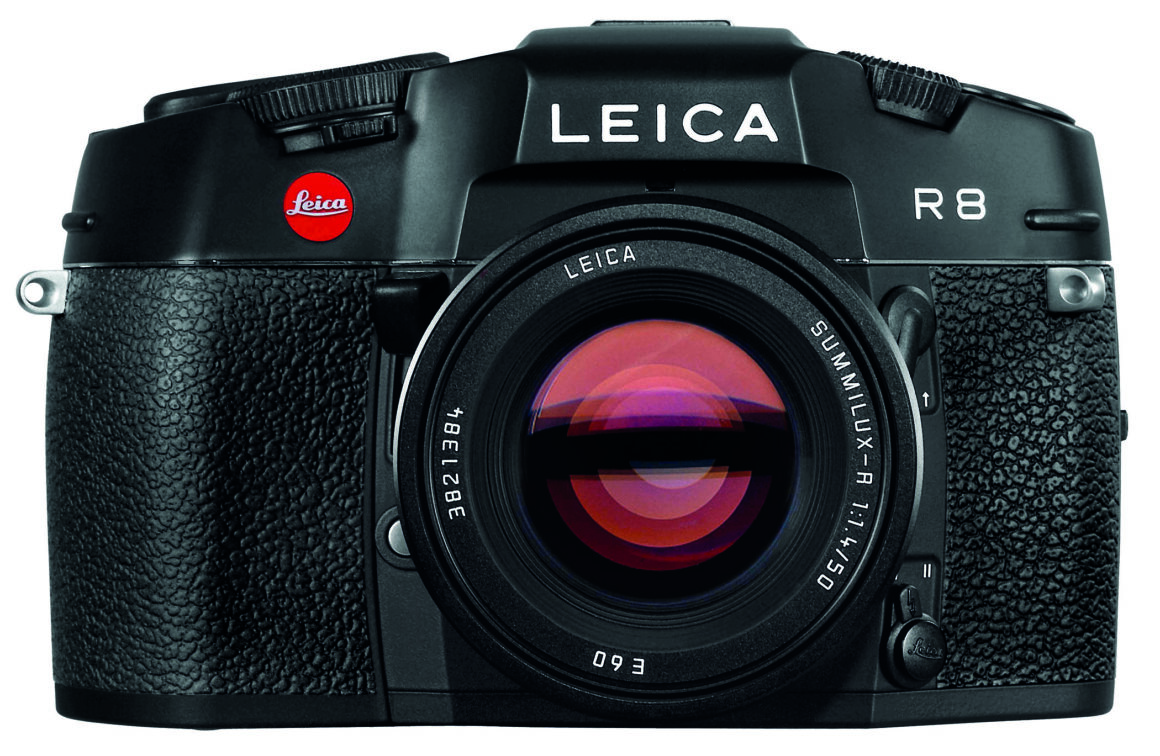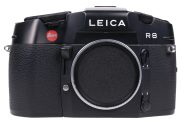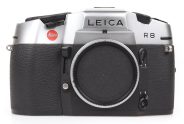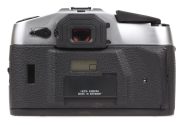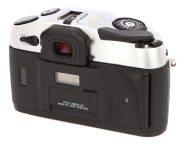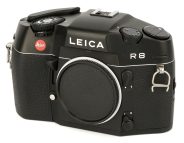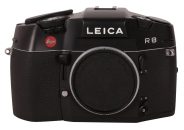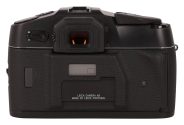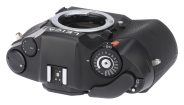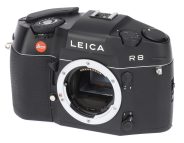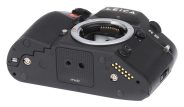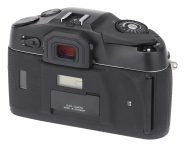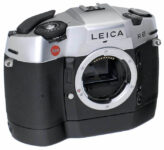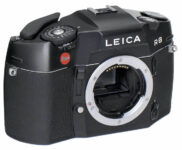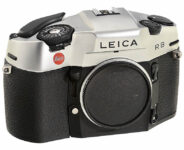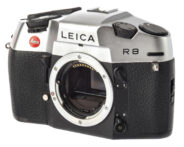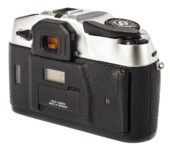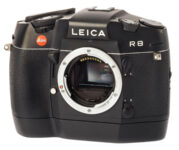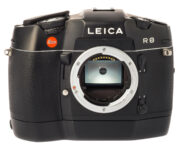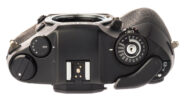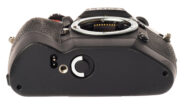Leica R8
35mm MF film SLR camera
Specification
| Production details: | |
| Announced: | 1996 |
| Order No.: | 10080 - silver chrome |
| 10081 - black chrome | |
| System: | ● Leica R (1964) |
| Format: | |
| Maximum format: | 35mm full frame |
| Film type: | 135 cartridge-loaded film |
| Mount and Flange focal distance: | Leica R [47mm] |
| Shutter: | |
| Type: | Focal-plane |
| Model: | Electronically controlled |
| Speeds: | 16 - 1/8000 + B |
| Exposure: | |
| Exposure metering: | Through-the-lens (TTL), open-aperture |
| Exposure modes: | Programmed Auto |
| Aperture-priority Auto | |
| Shutter-priority Auto | |
| Manual | |
| Physical characteristics: | |
| Weight: | 890g |
| Dimensions: | 158x101x62mm |
| Accessories: | |
| Body cap: | 14103 |
Manufacturer description #1
LEICA R8 and LEICA R6.2: two typical Leica single lens reflex cameras, both of the highest standard of quality – even though they were designed for different photographic applications. Our latest SLR design, the LEICA R8, represents all our optical and mechanical know-how, it embodies the outstanding results of years of development work. Because with the LEICA R8 we want to offer you a unique technological masterpiece. This camera meets the highest demands down to the smallest detail in order always to deliver the very best: brilliant photographs, even under extremely difficult light conditions.
The LEICA R8 provides you with the gratifying confidence of being able to rely fully and totally on precise automatic procedures – as long as you so desire. But you can also exercise your creative latitude as much as you wish with all camera functions. With its manifold manual setting possibilities, the R8 always leaves it up to you to what extent you wish to control the exposure yourself. It offers you the freedom of expressing all your ideas creatively. Or, are you the type of photographer who always wishes to compose his pictures himself, individually? And do you therefore give basic preference to manual settings and purely mechanical operation? If so, you will probably wish to dispense with cleverly designed electronic refinements entirely.
In that case you can implement your creative talents in an ideal manner with the LEICA R6.2. With its sturdy and durable design, you can also unhesitatingly subject this camera to the toughest challenges – it always functions with absolute accuracy and dependability. Even under extreme climatic conditions. Our LEICA R cameras follow different concepts.
But both of them have one thing in common: the highest quality of fabrication of every individual component and of the entire manufacturing process – something that you can rightfully expect from Leica. In addition, we have an excellent selection of practical accessories available for both cameras; and of course, a very extensive array of superb lenses whose performance is praised by experts all over the world.
Manufacturer description #2
Plus points of the LEICA R8 at a glance
- The distinctive styling of the LEICA R8 stands out for its unique clarity and timeless elegance.
- Its sturdy metal construction makes it robust and durable.
- Thanks to its outstanding ergonomic design, the LEICA R8 fits very well in the hands, even with long focal length lenses.
- All major controls are shaped for comfortable handling and positioned for convenient access.
- The viewfinder display always provides an exact overview of all the important exposure information, along with an exceptionally bright and contrasty image.
- The fast shutter with speeds up to 1/8000 second opens new opportunities for creative picture compositions.
- In addition to the proven large field integral and selective exposure metering, the multi-pattern exposure metering enables you to photograph new and unusual subjects.
- The aperture prioriy, shutter and manual priority, programmed automatic, exposure control modes can be freely combined with any of the above three metering methods. The automatic program mode offers creative freedom, because the indicated shutter speed and aperture pairs can be varied at will.
- Several flash-, metering- and control functions provide extensive creative possibilities: from the precise analysis prior to the actual exposure to the automatic dosing of full flash or fill-in flash illumination.
- The focal lengths of the extensive line of world-famous LEICA R lenses range from 16 mm to 800 mm. They are compatible with earlier as well as future R cameras.
- A comprehensive line of practical accessories is available for the LEICA R8.
Manufacturer description #3
Timeless design
The LEICA R8 sets new design standards thanks to the perfect clarity of its lines combined with a hitherto unsurpassed functionality. Easy-grip, optimally positioned controls for simple, safe handling.
Fast shutter
The fast shutter (1/8000 - 32 s) opens up every possibility for creative photography - under natural light conditions, as well artificial lighting. Flash synchronisation 1/250 s.
Three metering methods
In addition to the customary selective and center-weighted metering methods, multi-pattern metering is also available. It automatically improves exposure reliability and opens up possibilities for exploring unusual motifs. All three metering methods can be combined freely with the four operating modes: speed or aperture priority, variable automatic program mode and manual settings. Perfect adaptability to every motif and situation.
Brilliant viewfinder
The new High-Eyepoint viewfinder with integral diopter adjustment provides all the information and offers a total overview at a glance. With a brilliant image and complete information.
Variable flash options
Expanded, effective, easy-to-use flash system ranging from individual pre-exposure analysis to fully automatic flash output control whether as main light source or fill-in flash (SCA 3000 system).
Unsurpassed mechanical precision and ruggedness
Thanks to its sturdy, tough metal design and the greatest care taken in the choice of material and manufacture right up to a final, one hundred percent check.
... Made in Germany
Technical data:
Type of camera: Microprocessor controlled single-lens reflex camera with multi-mode automatic functions and motor-drive connection facility
Lens mount: LEICA R-bayonet with additional electrical contacts. All LEICA R-lenses with focal lengths from 15 mm to 800 mm may be used, as well as the earlier LEICAFLEX/SL/SL2 lenses retrofitted with R-type control cams
Exposure metering methods: TTL metering, switchable to selective metering. Full-field integral metering and multiple field metering, freely combinable with the various operating modes. Exposure override +/- 3 exposure values in half stops
Operating modes: A- Aperture priority; T - Shutter priority; P - Variable automatic program model; F - Pre-flash metering; m - manual setting of shutter speed and aperture
Shutter: Microprocessor controlled, metal blade focal-plane shutter; continuous from 32 s to 1/8000 s in automatic mode; in manual mode from 16 s to 1/8000 s (also half values); X (=1/250 s) for flash sync.
Film speed settings: Manual settings from ISO 6/9° to ISO 12800/42°; Automatic settings (DX) from ISO 25/15° to ISO 5000/38°
Shutter release: Easy-access shutter release button (with cable-release connector); Self-timer: 2 different countdown times (2 s and 12 s), flashing LED display during countdown; Option of Leica R8 MOTOR-WINDER/DRIVE attachments; Multiple exposure, also motorised; Mirror lock-up (after preselection via shutter release); Bracketing: in conjunction with the R8 DRIVE 3 different frames can be shot optionally at 1/2 EV or 1 EV exposure difference.
Film transport: Simple, rapid operation by means of automatic film threading mechanism, even on manual wind; Film advance: manual by means of rapid winding lever or motorised wind using MOTOR-WINDER R8 (2 fps) or MOTOR-DRIVE R8 (2 fps or 4 fps); Film rewind: manual or motorised using winder or drive attachment; Frame counter: in viewfinder and exterior display; Multiple exposure: any number of multiple exposures are possible without a frame mismatch or advancing the counter.
Flash photography: Flash synchronisation: 1/250 s. Programs P and A automatically switch over to flash sync. Longer speeds available using programs m and T; TTL flash exposure metering: centre-weighted integral metering with system-compatible flash equipment and SCA 3501 adapter; Flash release: via central X hot-shoe contact or standard X contact socket. 1st or 2nd shutter curtain option; Metering flash before the frame is shot. Selective TTL metering, even with non-dedicated flash, e.g., studio flash equipment; Film speed range for TTL flash exposure metering: TTL flash exposure metering: ISO 12/12° to ISO 3200/36°, TTL metering flash: ISO 25/25° to ISO 400/27°; Flash equipment zoom reflector: automatic setting with appropriate flash equipment using adapter SCA 3501 and lenses with electronic focus identification.
Viewfinder system: High Eyepoint viewfinder, diopter correction +/- 2 dptr.; Additional mounting for correction lenses +/- 3 dptr.; Integral pentaprism; Five interchangeable focusing screens; Clear LCD display of all relevant information in viewfinder
Other camera features: Tripod thread: A 1/4 (1/4") DIN 4503; Power supply: 2 CR2 lithium cells
Dimensions and weight: Width 158 mm, Height 101 mm, Depth 62 mm, Weight 890 g
The LEICA R8 is available in black chrome and silver chrome finish.
From the editor
Introduced at Photokina 1996, the Leica R8 was a completely new design, both technically and aesthetically.
In late 2004 the Leica DIGITAL-MODUL-R became available to convert the R8 into a high performance digital camera.
The lens mount is standard Leica R bayonet with additional electrical contacts for the transmission of data and signals between the camera and the lenses. The camera still could accept all existing and past Leica R lenses.
